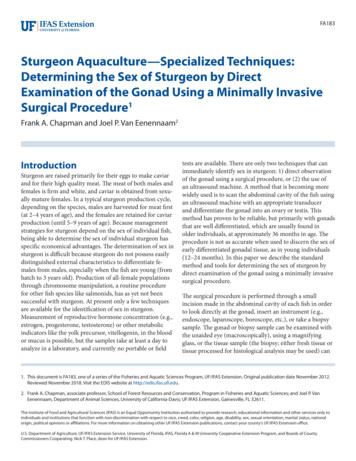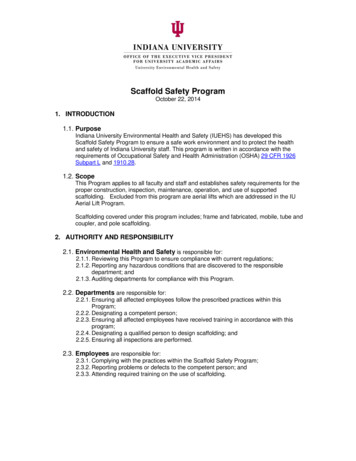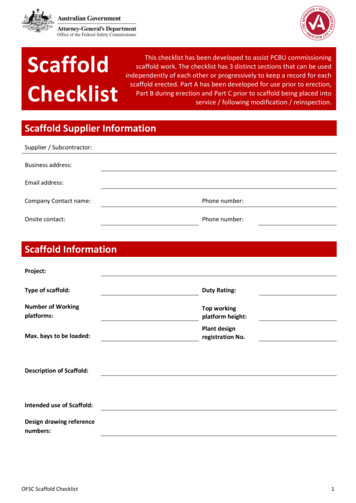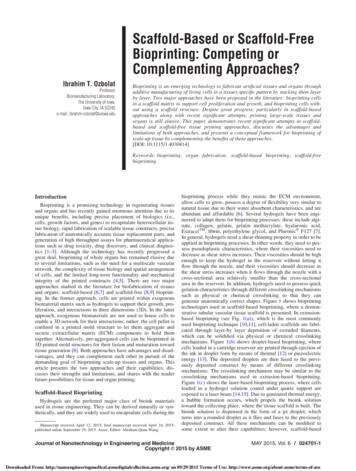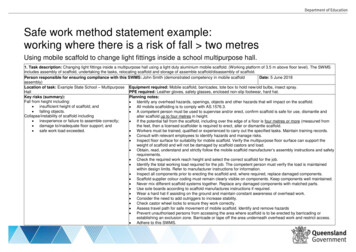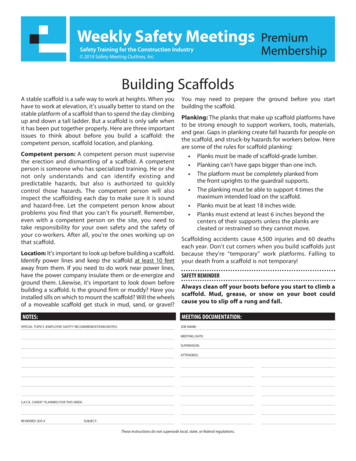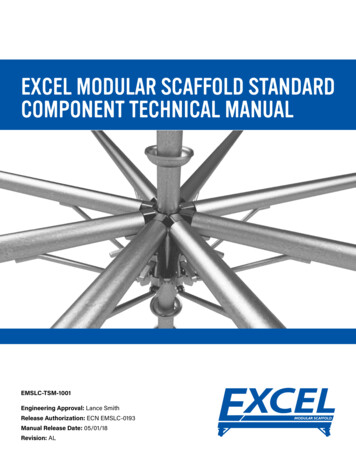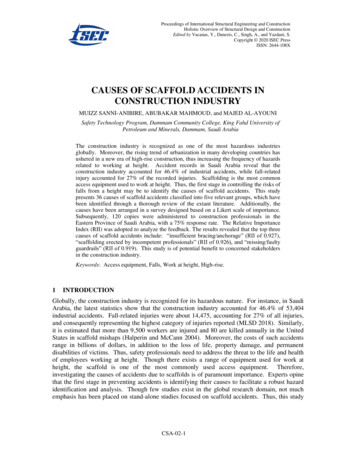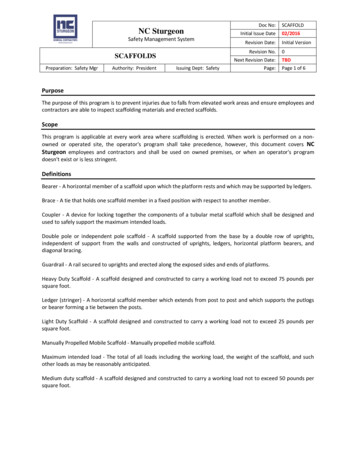
Transcription
NC SturgeonSafety Management SystemAuthority: PresidentInitial Issue DateRevision Date:Revision No.SCAFFOLDSPreparation: Safety MgrDoc No:Next Revision Date:Issuing Dept: SafetyPage:SCAFFOLD02/2016Initial Version0TBDPage 1 of 6PurposeThe purpose of this program is to prevent injuries due to falls from elevated work areas and ensure employees andcontractors are able to inspect scaffolding materials and erected scaffolds.ScopeThis program is applicable at every work area where scaffolding is erected. When work is performed on a nonowned or operated site, the operator's program shall take precedence, however, this document covers NCSturgeon employees and contractors and shall be used on owned premises, or when an operator's programdoesn't exist or is less stringent.DefinitionsBearer - A horizontal member of a scaffold upon which the platform rests and which may be supported by ledgers.Brace - A tie that holds one scaffold member in a fixed position with respect to another member.Coupler - A device for locking together the components of a tubular metal scaffold which shall be designed andused to safely support the maximum intended loads.Double pole or independent pole scaffold - A scaffold supported from the base by a double row of uprights,independent of support from the walls and constructed of uprights, ledgers, horizontal platform bearers, anddiagonal bracing.Guardrail - A rail secured to uprights and erected along the exposed sides and ends of platforms.Heavy Duty Scaffold - A scaffold designed and constructed to carry a working load not to exceed 75 pounds persquare foot.Ledger (stringer) - A horizontal scaffold member which extends from post to post and which supports the putlogsor bearer forming a tie between the posts.Light Duty Scaffold - A scaffold designed and constructed to carry a working load not to exceed 25 pounds persquare foot.Manually Propelled Mobile Scaffold - Manually propelled mobile scaffold.Maximum intended load - The total of all loads including the working load, the weight of the scaffold, and suchother loads as may be reasonably anticipated.Medium duty scaffold - A scaffold designed and constructed to carry a working load not to exceed 50 pounds persquare foot.
NC SturgeonSafety Management SystemAuthority: PresidentInitial Issue DateRevision Date:Revision No.SCAFFOLDSPreparation: Safety MgrDoc No:Next Revision Date:Issuing Dept: SafetyPage:SCAFFOLD02/2016Initial Version0TBDPage 2 of 6Mid-Rail - A rail approximately midway between the guardrail and platform, used when required, and secured tothe uprights erected along the exposed sides and ends of platforms.Putlog - A scaffold member upon which the platform rests.Runner - The lengthwise horizontal bracing or bearing members or both.Scaffold - Any temporary elevated platform and its supporting structure used for supporting workmen or materialsor both.Toe board - A barrier secured along the sides and ends of a platform, to guard against the falling of material.Tube and coupler scaffold - An assembly consisting of tubing, which serves as posts, bearers, braces, ties, andrunners, a base supporting the posts, and special couplers which serve to connect the uprights and to join thevarious members.Tubular welded frame scaffold - A sectional, panel, or frame metal scaffold substantially built up of prefabricatedwelded sections that consist of posts and horizontal bearer with intermediate members. Panels or frames shall bebraced with diagonal or cross braces.Working Load - Load imposed by men, materials, and equipment.Key ResponsibilitiesManagers and Supervisors Responsible for ensuring that scaffolds are erected by a qualified person, that set up inspections areperformed, and all daily inspections are performed before work starts for the day. Responsible for ensuring that all employees, and/or contractors have been trained in the use andinspection methods for scaffolds. Responsible for ensuring that all employees and contractors are aware that if an inspection discovers adefect, the scaffold cannot be used until repairs are made.Employees Responsible for following this program by inspecting the scaffolds daily and report any damages or repairsthat may be needed to their supervisor.ProcedureGeneral RequirementsScaffolds shall be furnished and erected in accordance with applicable standards for persons engaged in work thatcannot be done safely from the ground or from solid construction. Except that ladders used for such work shallconform to ladder safety standards.Scaffolds shall only be erected by a qualified third party, who is competent to certify the scaffolding safe to use.
NC SturgeonSafety Management SystemAuthority: PresidentInitial Issue DateRevision Date:Revision No.SCAFFOLDSPreparation: Safety MgrDoc No:Next Revision Date:Issuing Dept: SafetyPage:SCAFFOLD02/2016Initial Version0TBDPage 3 of 6The footing or anchorage for scaffolds shall be sound, rigid, and capable of carrying the maximum intended loadwithout settling or displacement. Unstable objects such as barrels, boxes, loose boards shall not be used tosupport scaffolds or planks.Scaffolds and their components shall be capable of supporting without failure at least four times the maximumintended loads. Scaffold components must meet OSHA requirements 29 CFR 1910.28 and 29 CFR 1926.451.Wood scaffold planks must be cross-supported every 8 feet. Scaffold deck boards shall be cleated, wired or nailedinto place.All working levels of scaffolds will be floored completely except where internal ladders require space for ladderopenings.Scaffolds and other devices mentioned or described in this program shall be maintained in safe condition.Scaffolds shall not be altered or moved horizontally while they are occupied.Any scaffold damaged or weakened from any cause shall be immediately repaired and shall not be used untilrepairs have been completed.Scaffolds shall not be loaded in excess of the working loads for which they are intended.Bolts used in the construction of scaffolds shall be of adequate size and in sufficient numbers at each connection todevelop the designed strength of the scaffold.All platforms shall be overlapped (minimum 12 inches) and secured from any movement.An access ladder or equivalent safe access shall be provided.Scaffold planks shall extend over their end supports not less than 6 inches or more than 18 inches.The poles, legs, or uprights of scaffolds shall be plumb, and securely and rigidly braced to prevent swaying anddisplacement.Materials being hoisted onto a scaffold shall have a tag line.Overhead protection shall be provided for workers on a scaffold exposed to overhead hazards.Toe boards and guardrails shall be installed if a scaffold or platform is erected to a height of 6 feet or more.Scaffolds shall be provided with a screen between the toe board and the guardrail, extending along the entireopening, consisting of No. 18 gauge wire one-half inch mesh or the equivalent, where workers are required towork or pass under the scaffolds.Work shall not be performed on a scaffold during storms or high winds.
NC SturgeonSafety Management SystemAuthority: PresidentInitial Issue DateRevision Date:Revision No.SCAFFOLDSPreparation: Safety MgrDoc No:Next Revision Date:Issuing Dept: SafetyPage:SCAFFOLD02/2016Initial Version0TBDPage 4 of 6Work shall not be performed on scaffolds that are covered with snow or ice, unless all snow and ice has beenremoved and all planking has been sanded to prevent slipping.Tools, material, and debris shall not be allowed to accumulate in quantities to cause a hazard.InspectionsScaffolding shall be inspected, by a qualified person, in conjunction with the manufactures requiredrecommendations. The competent person must also insure scaffolds are safe prior to and during scaffold use. At a minimum, the following shall be inspected by the competent person after erection, before the startof the day or beginning of a shift change to ensure scaffolds are safe prior to and during use:oooo Ground or surface footing shall be inspected to ensure that there is no settling.All main supports and cross braces shall be inspected for any signs of damage, missing pins, boltsand any locks and/or safety keepers.All walking surfaces and/or planks shall be inspected for damage and proper placements and anypossible movement.All walkways and planks must be secure to prevent any movement.Inspection shall be made to ensure that the scaffold is stable and any movement is prevented.If during the inspection, a defect or damage to the scaffold is discovered, the scaffold shall be tagged outby the competent person, complied with and use prohibited until needed repairs are made.Mandatory Signs and TagsSigns and tags shall be visible at all times when work is being performed, and shall be removed or coveredpromptly when the hazards no longer exist.Defective or unsafe equipment or conditions shall be tagged out by the competent person using a weatherresistant tag secured to the scaffolding structure on all four sides and must be complied with. An example wouldbe improper footing conditions were observed.Danger signs shall be used only where an immediate hazard exists. Danger signs must be posted around theimmediate area of the scaffold, to alert other workers of possible danger from falling objects from the scaffold.Caution Signs and/or barricade tape shall be used to mark off a larger area around scaffolding warning otherworkers to use caution.ModificationsModification and repairs shall be performed by a qualified person, who is competent to certify the scaffolding safeto use to ensure non-qualified personnel do not create additional hazards.Employees shall not perform any modifications or repairs, unless they have been trained and certified, and failureto comply may result in disciplinary action and or termination.
NC SturgeonSafety Management SystemAuthority: PresidentInitial Issue DateRevision Date:Revision No.SCAFFOLDSPreparation: Safety MgrDoc No:Next Revision Date:Issuing Dept: SafetyPage:SCAFFOLD02/2016Initial Version0TBDPage 5 of 6Training RequirementsNC Sturgeon is required to train all employees that work on scaffolds regarding hazards by "qualified" persons.The supervisor shall have each employee who performs work while on a scaffold trained by a person qualified inthe subject matter to recognize the hazards associated with the type of scaffold being used and to understand theprocedures to control or minimize those hazards. The training shall occur before use and include the followingareas: Basic safety information.Hazards including fall protection, electrical safety, falling object protection.Tags – types and the requirement to comply with.The proper use of the scaffold, and the proper handling of materials on the scaffold.The correct procedures for dealing with electrical hazards and for erecting, maintaining, anddisassembling the fall protection systems and falling object protection systems being used.The maximum intended load capacity of the scaffolds used.The supervisor shall have each employee who is involved in erecting, disassembling, moving, operating, repairing,maintaining, or inspecting a scaffold trained by a competent person to recognize any hazards associated with thework in question. The training shall include the following topics, as applicable:The nature of scaffold hazards.The correct procedures for erecting, disassembling, moving, operating, repairing, inspecting, andmaintaining the type of scaffold in use.The design criteria, maximum intended load-carrying capacity and intended use of the scaffold.When the employer has reason to believe that an employee lacks the skill or understanding needed for safe workinvolving the erection, use or dismantling of scaffolds, the employer shall retrain each employee so that therequisite proficiency is regained. Retraining is also required in at least the following situations: Where changes in scaffolding at the worksite present a hazard about which an employee has not beenpreviously trained.Where changes in the types of scaffolds, fall protection, falling object protection, or other equipmentpresent a hazard about which an employee has not been previously trained.Where inadequacies in an affected employee's work involving scaffolds indicate that the employee hasnot retained the requisite proficiency.
Doc No:NC SturgeonInitial Issue DateSafety Management SystemRevision Date:Revision No.SCAFFOLDSPreparation: Safety MgrAuthority: PresidentNext Revision Date:Issuing Dept: SafetyPage:SCAFFOLD02/2016Initial Version0TBDPage 6 of 6Tube And Coupler Scaffolds - Light DutyUniformly distributed loadNot to exceed 25 p.s.f.Post Spacing (longitudinal)10 ft. 0 in.Post Spacing (transverse)6 ft. 0 in.Working LevelsAdditional Planked LevelsMaximum Height18125 ft.24125 ft.3091 ft. 0 in.Tube And Coupler Scaffolds - Medium DutyUniformly distributed loadNot to exceed 50 p.s.fPost spacing (longitudinal)8 ft. 0 in.Post spacing (transverse)6 ft. 0 in.Working LevelsAdditional Planked LevelsMaximum Height16125 ft.2078 ft. 0 in.
Safety Management System Doc No: SCAFFOLD Initial Issue Date 02/2016 Revision Date: Initial Version SCAFFOLDS Revision No. 0 . Scaffold components must meet OSHA requirements 29 CFR 1910.28 and 29 CFR 1926.451. Wood scaffold planks must be cross-supported every 8 feet. Scaffold deck boards shall be cleated, wired or nailed
